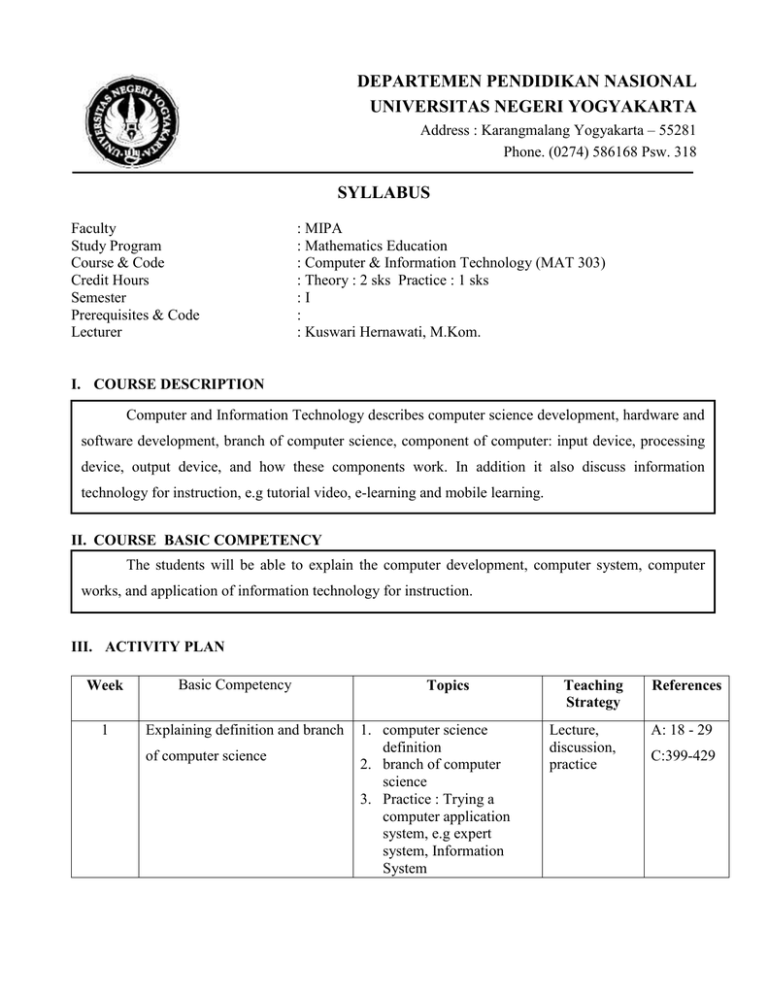
DEPARTEMEN PENDIDIKAN NASIONAL
UNIVERSITAS NEGERI YOGYAKARTA
Address : Karangmalang Yogyakarta – 55281
Phone. (0274) 586168 Psw. 318
SYLLABUS
Faculty
Study Program
Course & Code
Credit Hours
Semester
Prerequisites & Code
Lecturer
: MIPA
: Mathematics Education
: Computer & Information Technology (MAT 303)
: Theory : 2 sks Practice : 1 sks
:I
:
: Kuswari Hernawati, M.Kom.
I. COURSE DESCRIPTION
Computer and Information Technology describes computer science development, hardware and
software development, branch of computer science, component of computer: input device, processing
device, output device, and how these components work. In addition it also discuss information
technology for instruction, e.g tutorial video, e-learning and mobile learning.
II. COURSE BASIC COMPETENCY
The students will be able to explain the computer development, computer system, computer
works, and application of information technology for instruction.
III. ACTIVITY PLAN
Week
1
Basic Competency
Explaining definition and branch
of computer science
Topics
1. computer science
definition
2. branch of computer
science
3. Practice : Trying a
computer application
system, e.g expert
system, Information
System
Teaching
Strategy
Lecture,
discussion,
practice
References
A: 18 - 29
C:399-429
2
3
4
5
6
7
8
9
10
Explaining number system, 1. Number system and its
computer data representation and
operation
calculating
number
system 2. Digital Data (bit, byte)
operation
3. Data representation.
4. Character Code
5. Practice: Using hardware
and software to represent
Number system and its
operation
Explaining computer system
1. Computer data
processing
2. Computer Hardware
3. Practice : Using software
computer activity
monitoring.
Explaining Input device, Output 1. Input device
Device, Input/Output device,
2. Output Device
storage device
3. Input/Output device
4. Storage device
5. Practice : Introduction of
Input, output and Input/
Output Device
Explaining Hardware and
1. Hardware development
software development
2. Software development
3. Practice: Introduction of
Hardware and software
Explaining computer Software & 1. Definition
software classification
2. Software Classification :
System Software
Application Software
3. Practice: Word processor
Explaining and practicing
1. Structure
Operating System
2. Command
3. Type
4. Practice: using some
operating system
Explaining and practicing
1. Office Software
Application Software
2. graphics Software
3. Mathematics Software
4. Practice : office
software, introduction to
graphics software and
Mathematics Software
MIDTERM
Explaining basics of computer
networking
1. Definition
2. Network methods
3. Network Topology
Lecture,
discussion,
practice
A : 36-82
C : 33 - 43
Lecture,
discussion,
practice
A :79 -123
B: 14 – 78
E:37 - 76
Lecture,
discussion,
practice
B : 23-36
Lecture,
discussion,
practice
B:1-9
C : 9 - 23
Lecture,
discussion,
practice
B : 9 – 13
E : 86
Lecture,
discussion,
practice
A:119-155
B :39– 67
C :319-347
127-131
E: 117-150
B:147-224
E : 87 - 96
Lecture,
discussion,
practice
Lecture,
discussion,
practice
A:147-172
B:71-100
11
Explaining and practicing
internet and its applications
12
Explaining intranet & extranet
13
Explaining dan using
Information Technology for
instruction
14
Explaining and practicing Elearning
15
16
Explaining and using Mobile
Learning
4. Practice: Introduction of
computer networking
command &
administration tool, card
network setting
1. Definition of internet
2. History & development
3. Application
4. Internet Security
5. Practice : Internet &
application
1. Intranet
2. Extranet
3. Practice: Share folder,
window messenger
1. Definition of
Information Technology
2. Information Technology
Hardware
3. Type of learning based
Information Technology
4. Practice: Using
instructional CD
1. Definition
2. Types of e-learning
3. Benefit of e-learning
4. Practice : using LMS
program
1. Introduction of mobile
learning
2. Mobile learning
technology
3. Mobile learning
development program
4. Practice :using mobile
learning program
packet
FINAL TEST
Lecture,
discussion,
practice
A:173-192
B:101-120
B:227-228
C:459-468
Lecture,
discussion,
practice
C:456-457
E:103-112
Lecture,
discussion,
practice
E:11-12
Lecture,
discussion,
practice
D:1-23
Lecture,
discussion,
practice
F: 7 - 18
F: 131-143
IV. REFERENCES
A. Brookshear, J. Glenn (2007) ,Computer Science, An Overview, New York : Pearson Addison
Wesley
B. Khanna, Rajiv (2008), Basics of computer Science, New Delhi , New Age International (P) Ltd.,
Publishers
C. Dale, Nell and Lewis, John(2002), Computer science illuminated, United States of America :
Jones and Bartlett Publishers, Inc.
D. Solomon Negash, Michael E. Whitman, Amy B. Woszczynski , Ken Hoganson, Herbert Mattord
(2008), Handbook of Distance Learning for Real-Time and Asynchronous Information
Technology Education, United States of America : Information Science Reference
E. Custom guide(2008), Computer Basics: Student Edition Complete, Minneapolis, USA, Custom
Guide Inc
F. David S. Metcalf, John M. De Marco (2006), mLearning: Mobile Learning and
Performance in the Palm of Your Hand, Massachusetts, HRD Press, Inc
IV. EVALUATION
No.
Component
1.
Tasks
2.
Performance in the class
3.
Midterm
4.
Final Test
5.
Practice
Total
Weight (%)
15%
25%
20%
20%
20%
100%

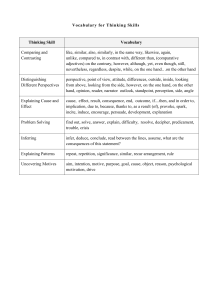
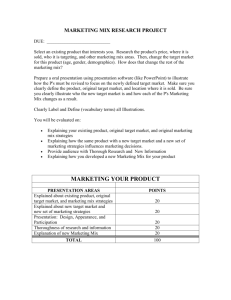
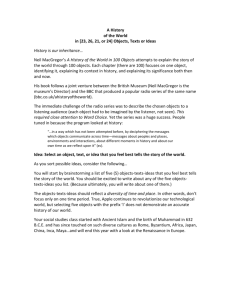
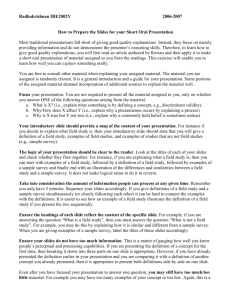

![A History of the World in [19, 23, 20, 23 or 27] Objects, Texts or Ideas](http://s3.studylib.net/store/data/006784667_1-4d5f43d658dd4cf65535087aa9e6a75a-300x300.png)